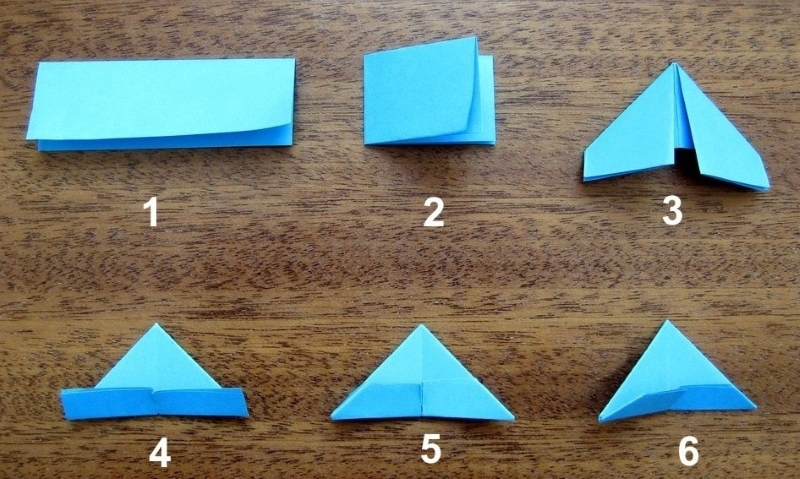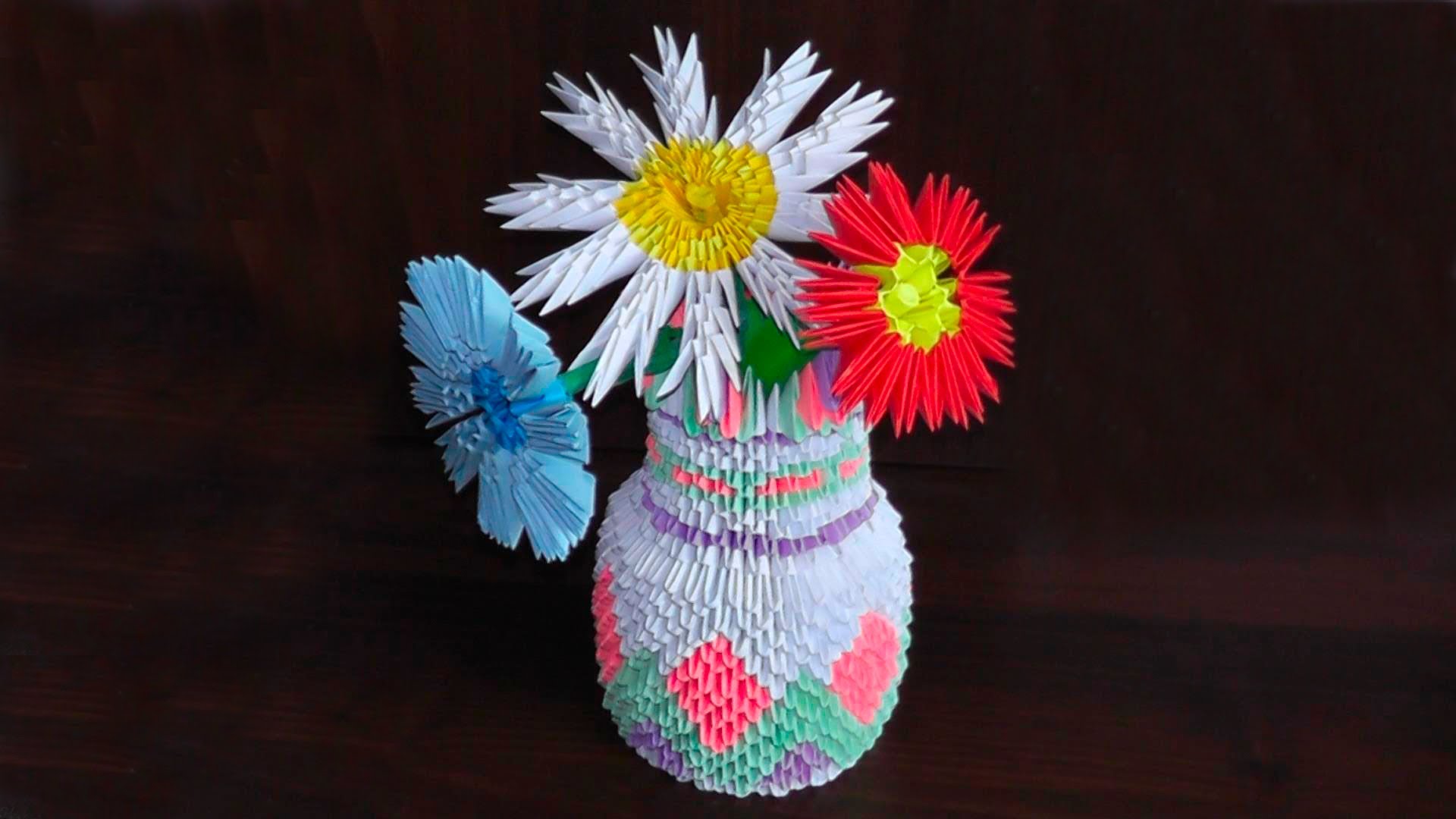In the final time, popularism became popular in such a direction as a modular origami, a master class “vase” for which is in high demand among people engaged in making homemade products. This is connected with the fact that this kind of home creation allows even those people who do not have special skills in origami style to perform rather complex products. In addition, the modular method also makes it possible to produce a wide range of handicrafts that can be used for quite practical targets in everyday life.
What is modular origami?
Important! Under the modular origami is meant the technique of folding a paper sheet, different from the classical one in that here during the folding of the craft, several paper sheets are used. In this case, any sheet is collected in the traditional technique, forming a module. In the future, similar modules are invested by a friend in a friend, forming very complex geometric shapes and products.
In this technique, it is possible to create very large objects, since frictional friction that occurs when creating and connecting modules does not allow the existing structure to collapse. As a result, you can create products that can not be done using traditional origami techniques. In this modular origami is quite difficult to master, so the master class for the manufacture, for example, of an object such as a vase, will be useful for beginners in this kind of handmade.
 In modular origami, the figures are entirely composed and attached using modules
In modular origami, the figures are entirely composed and attached using modules
Having prepared the same standard modules in advance, you can subsequently use them to create a variety of figures, geometric configurations, as well as various flat products. At the same modular origami can not do without the use of glue and other fastening means, since the designs made with it can sometimes be quite dimensional. Only in the simplest cases can the strength of a product here be given to natural friction.
Interesting! Modules can be either flat or three-dimensional. So, so, if you are studying modular origami, the master class on the subject “vase” will inevitably include the creation of polygons. They will become the basis of such a vase. In addition, vertices, stars and rings can be used as modules. Of these, in the future, the main compositions of a very complex structure are created.
What touches the most common with this origami body, the main here are:

Origami Kusudama – production of modular figures of paper in a spherical configuration
Kusudama is a volumetric body of spherical configuration assembled from paper colors. In Ancient Japan, these objects were used to treat patients, because they invested medicinal plants, and the kusudama itself was hung over the bed of the patient. At present, this form is used to create any objects of a spherical configuration, while its constituent parts can be stuck together and sewed together.
What touches a sonoboo, then this form is a parallelogram. Available in her 2 pockets allow you to connect to similar figures, as a result, you can create almost any three-dimensional shape. It may be the same vase, but of a different kind.

Modular Origami Sonobu – figures from modular parallelograms
Assembling a triangular module
Much! One of the most common modules in this origami technique is the triangular module. Having learned to add it, in the future it will be possible to start making the most diverse models and figures of varying degrees of complexity. So, for example, a modular origami using the shown module can be made in the form of a product “floor vase”, a class expert on which is very common on the Internet.
It should be noted that the triangular module is not an element of the Kusudama, as it, unlike them, does not stitch together and do not stick together with other origami elements. Here, the entire load is created by the force of friction, because of which it is possible to base various modular figures, having only one paper at hand. This is very convenient in the case when it is necessary to work outside the home workshop.

Making a triangular origami module
So, in order to create a triangular module, you will need to take a solid sheet of A4 paper and bend it in half. Further such sheet is bent once more, already across. This is done in order to mark out half the module, so once it is defined, you need to unbend the sheet backward. The resulting line will need to be guided by further work.
Now it will be necessary to bend the edges of the sheet to the intended mid-section of the sheet at a right angle, performing an element similar to the wings of a paper airplane. Next, the sheet is turned over and its lower part is bent upward along the edge of the formed triangle. After that, the corners are wrapped around the sides of the resulting large triangle.
The next stage of work is the extension of the lower part of the sheet back, leaving the corners bent. The existing corners are folded inwards in such a manner that they are not noticeable, while the trapezoidal parts must be bent upward. If the triangle we have created is bent in half, the required source module will be released.
Later, when collecting hand-made articles with the help of such a module, it will be necessary to use the pockets and corners in it. So, for example, modular origami, master class “vase” means as one of the options for creating this product using just the modules with such elements here. At the same time, rather robust structures are obtained, which can not only be suspended in the air, but also mounted on a table.
Creating a flower vase
One of the most common forms of products for beginners in the form of art described by us is the modular origami vases, schemes and classroom which are among the most popular on the Internet. At the same time, the first step for its creation is to study the ways of combining the primary elements of the product with a friend. Usually, corners and pockets are used for this. The first ones are inserted into the second ones, basing, at the expense of friction, a strong connection.

Making a vase in the technique of modular origami
In a similar technique, as a modular origami vase, assembly schemes and a master class for this type of work, the modules are fastened with two corners from different modules placed in the pockets of the third module. In addition, there is also a scheme for doubling the modules. In this case, only one corner is placed in the third module, the second pocket remains empty. In the resulting series, the module is connected in the usual manner.
As for the direct manufacture of a vase for paints in the technique described, 436 snow-white, 105 blue, 177 green, 45 crimson and 9 one-time modules will have to be used to create it in advance. To start, take 3 white modules and 2 of them are inserted in the third, then the scheme repeats. The result should be to connect together 48 modules in one line, while for the strength of the vase at once 3 rows are added.
 You can base modular compositions with origami vases.
You can base modular compositions with origami vases.
Further, the edges of the rows are joined together, and the resultant ring is turned outward. Then, in the fourth line, 4 green modules are put on and along the entire circumference the modules of different colors of the same number. On the fifth row, you have to make a displacement of the modules. In the sixth line, due to the reduction in the number of modules, it will be necessary to take instead of four 3 modules of different colors, and all of them should be 36 instead of 48.
In the seventh line again reduce the modules to 30, taking 2 modules of white paint. In the fourteenth, we use the blue modules fixed with crimson ones, preserving the existing sequence of colors. From the fifteenth to the eighteenth row, we select the color range depending on the imagination. The nineteenth row will be snow-white, and the number of modules will grow to 36. The twentieth row is performed in a similar way.
The paper vase for paints is finished with the modular origami method using the twenty-second series consisting of 36 modules of grass color.
Using vases of origami
In spite of the fact that origami is an art designed for the first priority for leisure, it can have a fairly wide range of areas of practical application. So, for example, the same vases and flowers, made in this way from paper, can be used to decorate various triumphs, for example, weddings. Such decorations are cheap and able for a short time to create a festive atmosphere in almost any room.

In addition, origami can come in handy and purely for practical purposes. For example, in paper vases you can set living flowers in case of need. Self-made similar products can also be designed for an original and memorable gift. By the way, it can be made right before the person, what you are going to present such a gift. Naturally, remembering it will be very long.
Separately it is worth mentioning the benefit that origami brings to children. The fact is that this handymade technique allows you to unwind the child’s fine motor skills and fantasy. These skills will be useful to him later in the course of schooling. In addition, the skills of working with hands will be necessary to him and in everyday life, for example, to decorate the apartment. All this speaks in favor of the case with this kind of handmeid.



